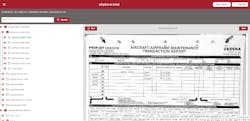Many aircraft owners find out too late the importance of logbooks; losing hundreds of thousands of dollars on the sale of their aircraft, or duplicating expensive maintenance tasks because records are missing; spending tens of thousands of dollars recreating these fragile, yet extremely important documents.
The entire aircraft maintenance record is a collection of documents that back up and support the airworthiness of an aircraft beginning in production. We often refer to these records as the aircraft’s “logbooks.”
Logbooks typically contain the age of the aircraft, its maintenance history, the total time on the aircraft when work was accomplished, major modifications accomplished since new, damage history to the aircraft, and any other information relative and important to understanding the aircraft’s history and Airworthiness.
Currently, almost all of these documents exist only in paper form. This, of course, can lead to quite a few problems. One missing document may mean the work needs to be performed again, wasting both money and the time the aircraft would otherwise be available to fly. Not to mention the time and cost incurred sending personnel all over the world because, in an industry that is worldwide in its operation, the records exist only in one place at a time (and are usually somewhat isolated at that).
Top aircraft appraisers and financial institutions would like to see well-organized, easily retrievable records that provide evidence of the legal Airworthiness of the aircraft. Good records usually reflect a well-cared-for aircraft. And, good records also save expensive maintenance time researching the history of the aircraft when looking for vital information.
Unfortunately, in our world of business aviation this is rarely what we find. Good records and good record keeping practices are seldom seen. What we mostly find are disorganized records thrown into cardboard boxes, stuffed into filing drawers and cabinets, kept in gun safes or shipping containers; utilizing any means of storing such a large amount of paper as an aircraft accumulates in its lifetime.
Paper records cost our business aviation industry over $150M every year. This is quickly becoming not only unacceptable, but intolerable by almost everyone.
As an industry, we can do better than just throwing our hands-up and accepting dysfunctional paper records as our destiny. So far, we haven’t done anything to solve this problem. But, indeed, as an industry we must.
With the aircraft we operate now flying faster, traveling farther, and operating more efficiently than ever before; why are we permitting the critically important records of these high-tech aircraft to continue to be treated so poorly? Adding to this conundrum are the coping methods we all employ to deal with paper records. These copying mechanisms are not only dysfunctional, but add cost and complexity to almost all areas of an aircraft’s operation.
We didn’t wait for the FAA to make a ruling allowing us to build pressurized aircraft, nor did we wait for weather radar or electronic flight instruments to become a rule before incorporating these technologies. So why are we continuing to wait for congress to pass legislation giving us permission to use electronic recordkeeping and digital signatures?
The following are a few suggestions I have of what we could, and should, as an industry, be doing to bring the 21st century system of electronic recordkeeping into our daily operations:
- Scan your existing paper records into electronic images in order to have both a backup of the paper record, and to begin the important process of converting the world of business aircraft recordkeeping from paper to electronic.
- Begin an electronic recordkeeping system containing the same information that you are currently keeping in your paper system. Since a paper system is still the accepted “norm”, run both systems in parallel (the time and manpower it takes to do this will be more than made up by the efficiencies that the electronic recordkeeping system adds to our operation).
- Start using a digital signature program to sign documents. Digital signature programs are readily available from several different sources you can find on the internet. And have been used by both the international banking community and real estate companies for over a decade.
- Write your congressman and insist that Congress pass laws now that will allow regulators to add language to the Title 14 CFRs that includes electronic recordkeeping and digital signatures. After all, it is the certainty of the future.
These first steps are always the hardest … and the most critical. As an operator of the most sophisticated business aircraft in the world, we need to take this first step. Both the aircraft we operate, and the people operating these aircraft will benefit. Most of business aviation is already employing 21st century practices. It’s imperative we act now to bring all of business aviation into the 21st century.
About the Author

Larry Hinebaugh
Larry Hinebaugh is currently the executive director of a non-profit company called The Foundation for Business Aircraft Records Excellence. Hinebaugh was instrumental in creating this company after seeing so many aircraft operators inconvenienced, and aircraft owners financially harmed, by our industry’s poor logbook practices. A 40-year veteran of the business aviation Industry, Hinebaugh started his career as an A&P technician in a small jet maintenance shop in California and has since worked as a field service representative for Gulfstream Aerospace, director of maintenance for several corporations operating large business aircraft, and president of Aviation Consulting Group providing maintenance and completion representation to companies operating aircraft from Cessna’s to Boeing’s; before accepting his position with Business Aircraft Records (BAR).
